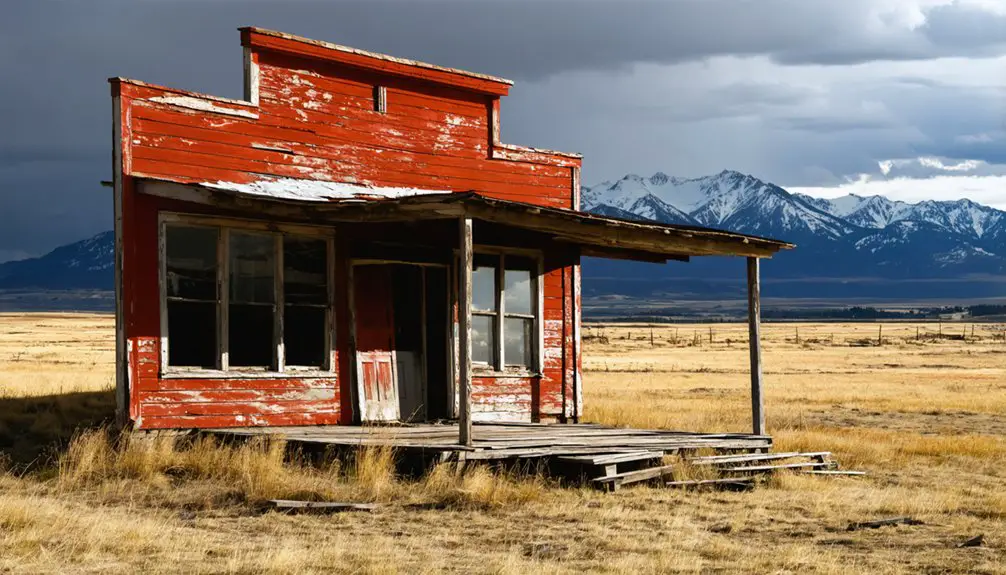You’ll find Ringling, Montana nestled in the shadows of the Castle Mountains, where the legacy of the famous circus family meets Montana’s railroad history. This ghost town emerged from John Ringling’s railroad ambitions and his family’s ranching ventures in the early 1900s. Today, you can explore the weathered St. John’s Church, the historic bar along Highway 89, and abandoned railroad tracks. The town’s haunting beauty and rich circus heritage hold countless stories within its quiet streets.
Key Takeaways
- Ringling, Montana, originated as a railroad hub and circus-connected town, now standing as a semi-abandoned settlement with historic buildings.
- The town features St. John’s Church (built 1910-1914) and a historic bar along US Highway 89 as primary remaining structures.
- Founded through John Ringling’s railroad investments, the town briefly prospered before declining when railroad operations diminished.
- The abandoned railroad tracks and weathered buildings attract photographers and artists seeking to capture Montana’s ghost town aesthetic.
- Located along Highway 89, Ringling preserves both circus history and ranching heritage through its remaining structures and community stories.
The Ringling Brothers’ Railroad Dreams
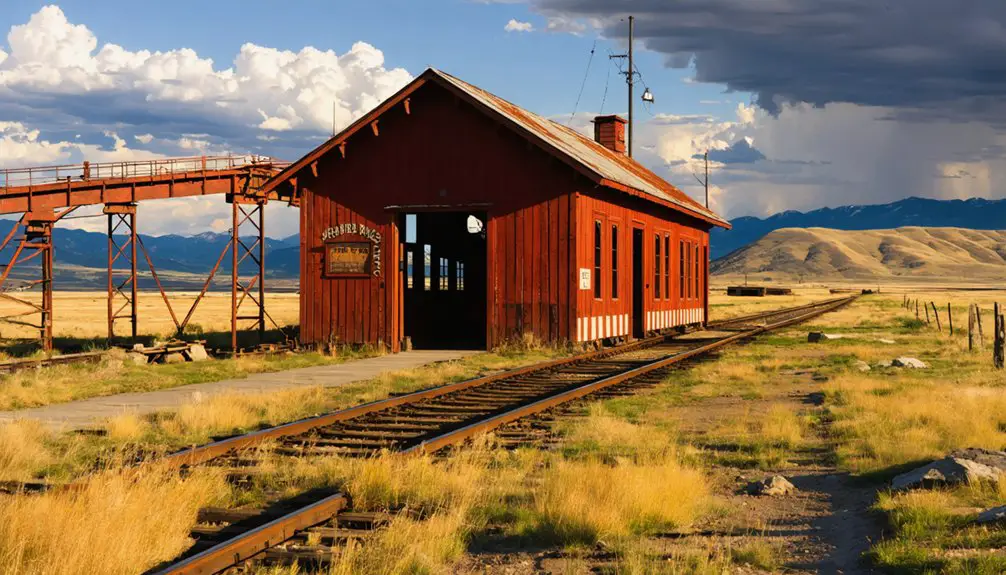
When the Ringling Brothers Circus began expanding westward in the late 19th century, they knew railroads would be essential to their success.
You’ll find their railroad logistics were impressive – they operated specialized cars designed for animal transport, including four elephant cars and a camel car by 1902. Each elephant car stretched 45 to 50 feet and could house six of these massive creatures.
What you mightn’t know is that John Ringling saw beyond just circus operations. In 1903, he visited Montana and spotted opportunities to combine circus routes with strategic land investments.
He acquired ranch properties near rail lines, transforming the Ringling empire from purely entertainment into a diverse business venture. The railroad infrastructure they built didn’t just move circus animals – it opened up Montana’s economic potential.
Life in a Circus Family Town
You’d still feel the circus spirit alive in Ringling’s weathered buildings, where train whistles once announced the arrival of performers and dreams of a grand railway hub sparkled in the Ringling brothers’ eyes.
The town’s daily rhythms followed both the practical needs of ranching and the showmanship inherited from its circus roots, creating a unique blend of Montana grit and entertainment flair.
Even as the population dwindled, families kept their circus heritage close, sharing stories of acrobats-turned-ranchers while tending to cattle under the big Montana sky.
Circus Legacy Lives On
Though the Ringling name evokes images of big-top spectacles and circus performers, the family’s legacy in Montana took root in a distinctly different way.
You’ll find their influence woven into the fabric of Montana’s ranching heritage, where circus nostalgia meets the rugged reality of rural life.
As you explore the area, you’ll discover how the Ringlings transformed from showmen to cattlemen. Richard Ringling’s move to Montana in 1917 sparked a new chapter, building a thriving cattle and sheep operation.
His son Paul carried on this tradition, proving that circus blood could adapt to ranch life. Even today, Ringling descendants maintain their connection to Montana’s wilderness, blending their famous family history with the practical skills of livestock management and wildlife conservation.
Daily Train Show Dreams
During the golden age of circus trains, Ringling’s daily rhythm pulsed with the arrival and departure of massive locomotives carrying dreams, sequins, and sawdust.
You’d wake to the sound of train whistles as circus logistics transformed your quiet Montana town into a bustling hub of activity.
Living in Ringling meant you’d witness the seamless dance of train operations – performers rehearsing between cars, animals being fed and tended, and crews maintaining the complex fleet that kept the show moving.
Your neighbors might include trapeze artists sharing stories at the local diner or animal handlers grabbing supplies for their next run.
The marriage of ranch life and circus culture created a unique community where you could tend cattle in the morning and watch acrobats practice their routines by afternoon.
Small-Town Circus Culture
Beyond the daily train shows, life in Ringling painted a rich tapestry of circus and ranch culture that defined our community’s unique character.
You’d find our circus traditions seamlessly woven into everyday ranching heritage, creating a lifestyle unlike anywhere else in Montana.
Our town’s distinctive spirit shines through:
- The Ringling Bar and Cafe serves as our gathering place, where circus tales mix with cattle talk
- St. John’s Church stands restored by our own hands, showing our dedication to preserving history
- The Ringling Dairy herd and Springs Creamery proves how we’ve adapted circus entrepreneurship to agricultural success
Fishing spots, rodeo grounds, and livestock operations keep us grounded, while the legacy of the Ringling family reminds us we’re part of something larger than our small-town borders.
St. John’s Catholic Church: A Standing Testament
St. John’s Catholic Church stands as a symbol of Ringling’s resilient spirit, its weathered wooden frame and distinctive cupola catching your eye along Highway 89. Built between 1910-1914, this architectural gem showcases unique Arts and Crafts elements you won’t find in typical rural Montana churches.
You’ll discover its cultural significance woven into regional literature, particularly in Ivan Doig’s “This House of Sky.”
Though the church’s interior was stripped to the studs in the 1980s, its exterior remains a powerful reminder of the town’s vibrant past.
Despite its gutted interior, St. John’s Catholic Church stands proud, its weathered facade echoing the spirit of Ringling’s glory days.
Now, thanks to local partners’ church restoration efforts in 2021, you’ll soon see this historic landmark transformed into a dynamic venue for weddings, music, and community gatherings, proving that even ghost towns can find new life through preservation.
From Railroad Hub to Ghost Town
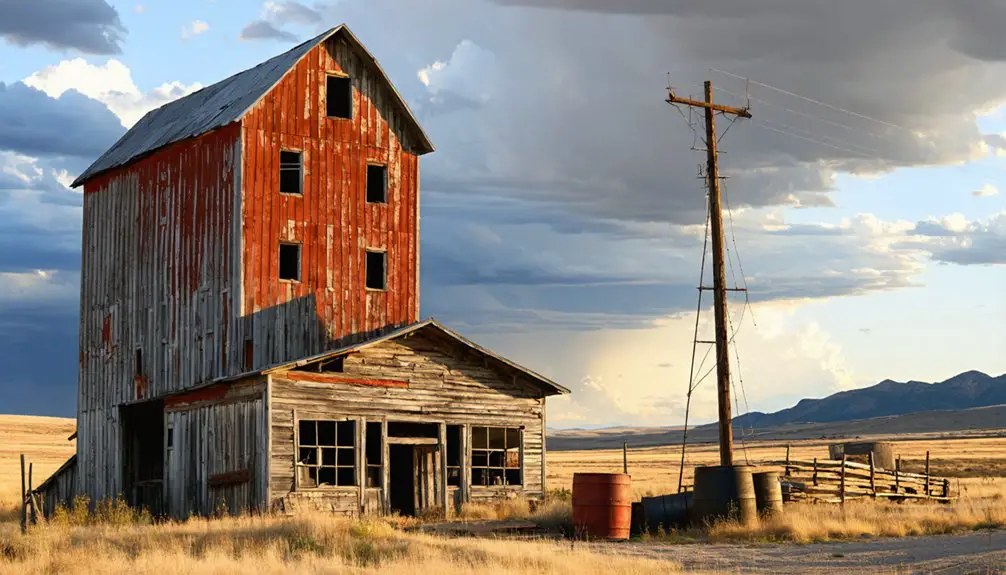
While John Ringling’s ambitious vision sought to connect Glacier and Yellowstone National Parks by rail, his dreams would materialize into just 23 miles of track linking Ringling to White Sulphur Springs.
The town briefly flourished as a strategic railroad hub, supporting both agricultural aspirations and circus operations with specialized railcars. Like the Chicago Milwaukee Railroad, which experienced significant growth between 1908-1920, Ringling’s railway operations showed early promise.
You’ll find evidence of Ringling’s railroad ambitions in the town’s early development, which focused on:
- Supporting extensive grain transport for a proposed farming empire
- Accommodating specialized circus cars with animal feeding troughs
- Facilitating freight and passenger service throughout central Montana
The Cultural Legacy in Art and Music
Although Ringling’s railroad dreams faded into history, the town’s cultural legacy lives on through art and music that capture its haunting beauty and complex past.
You’ll find photographers and painters drawn to the ghost town’s rustic landscapes, creating works that explore themes of abandonment and frontier nostalgia. The historic church, once a bustling community center, now hosts musical gatherings where local performers blend Old West narratives with contemporary sounds. Like many Montana mining towns that supported twenty-two saloons, Ringling’s vibrant nightlife culture echoes through modern artistic interpretations. Similar to Bannack State Park, the site preserves authentic architectural remnants that provide inspiration for creative works.
Cultural preservation efforts showcase Ringling’s unique circus connection through art installations and music festivals. Local musicians incorporate the town’s atmospheric backdrop into their compositions, while community art projects keep its historical identity alive through murals and exhibitions.
You’ll discover how Ringling’s symbolism as a boom-and-bust town continues to inspire artistic expression across Montana.
Exploring Ringling’s Historic Ruins
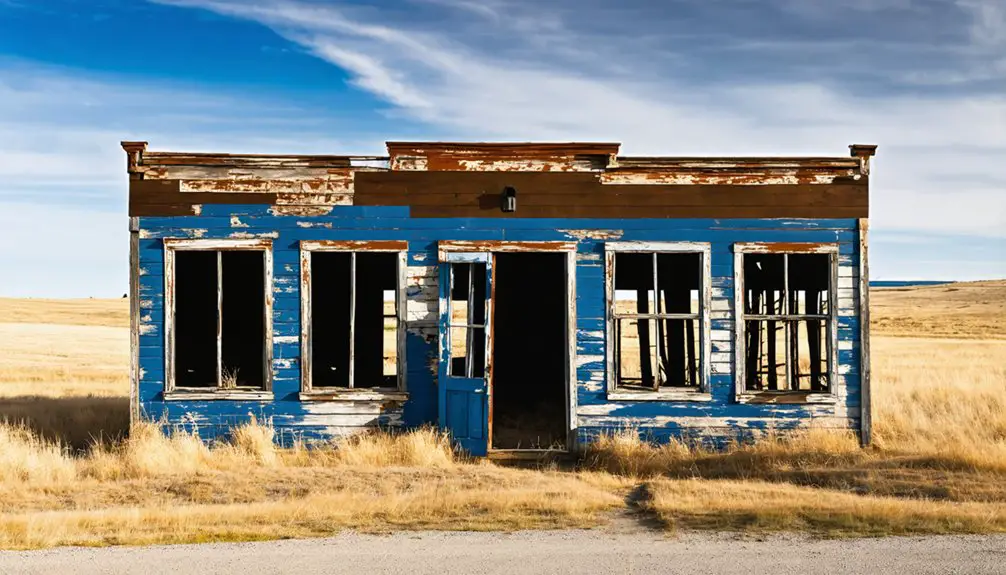
You’ll find the restored church standing proudly as Ringling’s most preserved landmark, with its gleaming white exterior now serving as a symbol of local preservation efforts.
Down the dusty main street, you’ll spot the old bar’s rustic facade, its weathered wood and faded signage telling stories of countless conversations and frontier revelry.
The abandoned railroad tracks that once brought dreams of prosperity now lay silent, winding through scattered ruins that remind us of Ringling’s ambitious past.
Church Remains Stand Tall
The bell tower of Ringling’s historic St. John’s Catholic Church stands as a tribute to the town’s enduring spirit. Built in 1914, this architectural landmark has witnessed dramatic transformations, from its early days serving the Catholic congregation to its current role as a vibrant community venue.
You’ll find the church’s remarkable journey reflected in its recent church restoration, which preserved key features while adapting to modern needs. Through dedicated community engagement, local partners saved this historic structure in 2021, creating:
- A unique wedding and music venue
- An Airbnb experience in the renovated parsonage
- A sustainable heritage site for public gatherings
Though stripped to its studs in the 1980s, today’s restored church remains blend historic charm with practical function, offering you a glimpse into Ringling’s past while serving present-day community needs.
Bar’s Weathered Western Charm
Standing proudly along US Highway 89, Ringling’s historic bar embodies the weathered soul of Montana’s frontier spirit.
You’ll find its weathered exterior telling stories of countless gatherings, where locals from Wilsall and White Sulphur Springs once shared tales over cold drinks and warm meals. This wasn’t just a bar – it was the town’s beating heart, doubling as a community center and town hall.
Step inside and you’re transported to another era. The rustic ambiance, with its time-worn wood elements and utilitarian fixtures, speaks to the bar’s role in railroad dreams and frontier expansion.
While John Ringling’s grand vision for a rail route between national parks never fully materialized, this resilient establishment persisted, serving hunters, travelers, and the handful of locals who’ve kept Ringling’s spirit alive.
Railroad Dreams Now Quiet
Dreams of a grand railroad empire now lie scattered across Ringling’s windswept landscape, where weathered foundations and railway embankments whisper stories of what might’ve been.
Back in 1910, John Ringling’s White Sulphur Springs and Yellowstone Park Railway promised to transform this valley into a bustling hub of commerce and tourism.
The railroad’s economic impact rippled through the region:
- Connected local ranchers to crucial market centers
- Provided essential transportation for cattle and sheep operations
- Sparked dreams of grand hotels and regional development
You’ll still find traces of this railroad nostalgia in the historic station ruins at White Sulphur Springs, while Ringling’s quiet streets remind you how quickly fortunes can change.
Modern-Day Visits and Photography
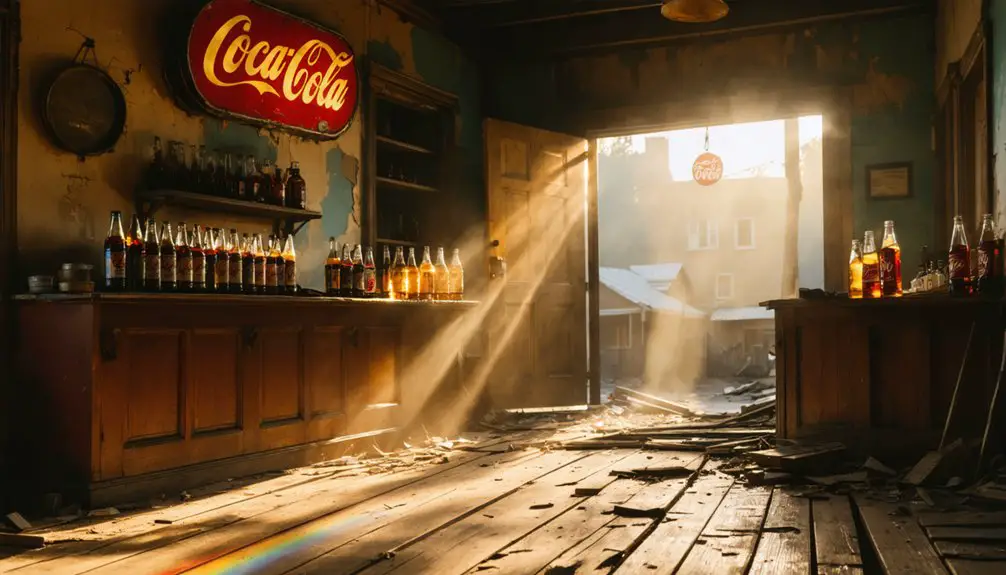
Modern visitors to Ringling, Montana find themselves stepping into a perfectly preserved slice of railroad history, where opportunities for exploration and photography abound.
Step back in time as Ringling’s well-preserved railroad heritage invites modern explorers to discover its photogenic historic treasures.
You’ll discover the iconic St. John’s Catholic Church, a favorite among photographers seeking to capture its timeless architecture against Montana’s expansive landscape.
Located near U.S. Highway 89, you can easily access the site by car and explore the remnants of this once-bustling railroad town. Like other ghost towns that showcase over 100 years of decay, Ringling offers visitors a genuine glimpse into the impermanence of human settlements.
For the best visitor experiences, plan your photography during sunrise or sunset when the light bathes the historic structures in golden hues.
Don’t miss the historic Ringling Bar, which serves as a welcome pit stop during your ghost town adventure.
While exploring, you’ll want to pack supplies and watch your step around aging structures, as amenities are limited in this authentically preserved setting.
Frequently Asked Questions
What Was the Peak Population of Ringling During Its Most Prosperous Years?
You’ll find that during its most prosperous years, around 1,000 people called this place home before population decline set in, marking a historically significant period of local growth and commerce.
Are There Any Remaining Descendants of the Ringling Family in Town Today?
You won’t find any Ringling family descendants living in town today. While the family’s legacy remains strong in local history, the last known Montana Ringling, Paul T., lived in Miles City until 2018.
What Businesses Operated in Ringling Besides the Railroad and Ringling Bar?
You’d have found a bustling general store supplying miners and ranchers, agricultural supply shops serving cattle ranching operations, blacksmith workshops, boarding houses, and warehouses supporting the region’s commerce.
When Was the Last Train Service That Operated Through Ringling?
You’ll find the last train through Ringling ran in June 1980, when King Wilson & Rockland Oil Company’s excursion service ended, marking the final chapter in your town’s proud railroad history.
Does Anyone Permanently Live in Ringling Now?
You won’t find any current residents permanently living there today – it’s a true ghost town. While you might hear tales of ghost sightings, the only visitors are curious travelers passing through.
References
- https://centralmontana.com/blog/ghost-towns-gold-mines-in-central-montana/
- https://centralmontana.com/communities/ringling/
- https://www.mtmemory.org/nodes/view/128482
- https://southwestmt.com/images/pdfs/Southwest-Montana-Ghost-Towns-Map.pdf
- https://www.youtube.com/watch?v=W5UcxnysyzI
- https://scholarworks.umt.edu/brown/72/
- https://backyard.circushistory.org/forums/10734989?tpg=3
- https://www.youtube.com/watch?v=mv7-dDxly7c
- http://www.helenahistory.org/ringling-bros-circus-1902.html
- https://www.distinctlymontana.com/three-ringlings-montana
